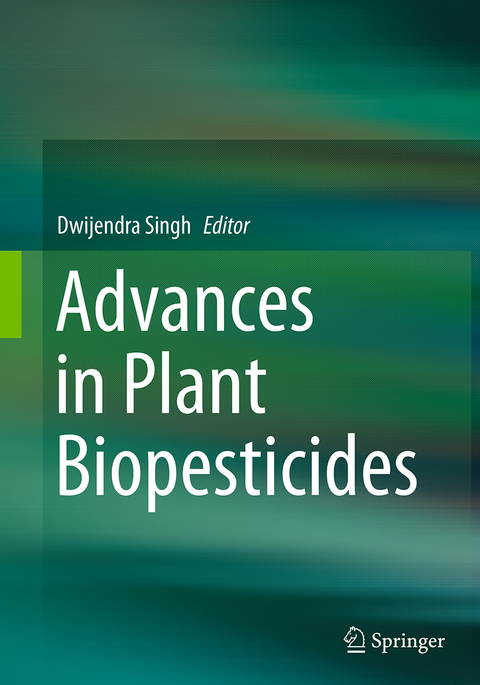
Advances in Plant Biopesticides
Springer, India, Private Ltd (Verlag)
978-81-322-3483-8 (ISBN)
Dr. Dwijendra Singh has served CSIR-CIMAP, Lucknow, in various capacities of research scientist heading the entomology division and reached to the level of Chief Scientist and Head, Crop Protection Division, Microbial Technology and Entomology Department, CSIR-CIMAP, Lucknow. Dr. Dwijendra Singh possesses 39 years of research experience in the field of applied and basic research in the area of entomology. During his career as scientist, Dr. Dwijendra Singh studied the major pests of medicinal and aromatic plants, phenology of various arthropods associated with mint, wormwood, opium poppy, henbanes and senna. He developed suitable sampling methods for major arthropods of mint species, organic method of white butterfly larvae management by altering sowing time in Cassia angustifolia, identified fennel as allelopathic plant species for mustard aphid management, screened whitefly and begomovirus resistant mint genotypes, investigated the effect of synthetic pesticides on biosynthesis of tropane alkaloids in henbane and menthol in mint as tools for developing integrated pest management. He invented insecticidal principles; himachalol and ß- himachalene from Himalayan cedar wood oil against adzuki bean beetles and houseflies, tylophorine from Indian ipecac leaves as antifeedants against Bihar hairy caterpillar, α-amyrin acetate and oleanolic acid from Catharanthus roseus as insect growth regulators against Helicoverpa armigera, developed cheapest and safe pulse grain protecting phyto-tablet formulation to manage Adzuki bean beetles, demonstrated azadirachtin and its formulations inducing alteration in protein profile of H. armigera larvae which may be utilized to develop novel bio-pesticides. He contributed significantly in development of high yielding pest and disease resistant variety of menthol mint- ‘Himalaya’ that brought revolution in indigenous mint oil production and menthol export. He has explored the possibility of developingnovel biopesticides from medicinal and aromatic plant species. He developed the technology on Pulse Grain Protecting Tablet, organic method of pest management in Indian senna and shared in development of agro-technology for new variety of mint – Himalaya. Dr. Singh’s research findings are evident by his credit to 80 research publications in reputed scientific journals of national and international importance, 2 granted Indian patents and 1 US patent. He has been one of the authors of three books apart from popular book and farm bulletin and has also served as an editorial board member in reputed journals.
1. Different Plant Families as Bioresource for Pesticides.- 2. Natural Insecticides from the Annonaceae – A Unique Example for Developing Biopesticides.- 3. Exploiting Phytochemicals for Developing Sustainable Crop Protection Strategies to Withstand Climate Change: Example from Africa.- 4. Development of Insect Resistance to Plant Biopesticides: An Overview.- 5. Efficacy of Major Plant Extracts/ Molecules on Field Insect Pests.- 6. Botanical Pesticides for the Management of Plant Nematode and Mite Pests.- 7. Plant Disease Management: Prospects of Pesticides of Plant Origin.-8. The Use of Plant Extracts for Stored Product Protection.- 9. Pesticidal Plants for Stored Product Pests on Small Holder farms in Africa.- 10. Non-Target Effects of Botanicals on Beneficial Arthropods with Special Reference to Azadirachta Indica.- 11. Progress in the Development of Plant Biopesticides for the Control of Arthropods of Veterinary Importance.- 12. Role of Plant Biopesticides in Managing Vectors ofCommunicable Diseases.- 13. Management of Mite Pests in Honeybee Colonies through Botanicals.- 14. Nanotechnology and Plant Biopesticides: An Overview.- 15. Phytochemical Pesticides.- 16. Mode of Action of Plant-Derived Natural Insecticides.- 17. Limitation of Plant Biopesticides.-18. Production and Consumption of Biopesticides.- 19. Formulation, Registration and Quality Regulation of Plant Biopesticides.
| Erscheinungsdatum | 10.10.2016 |
|---|---|
| Zusatzinfo | 25 Illustrations, color; 42 Illustrations, black and white; XV, 401 p. 67 illus., 25 illus. in color. |
| Verlagsort | New Delhi |
| Sprache | englisch |
| Maße | 178 x 254 mm |
| Themenwelt | Medizin / Pharmazie ► Medizinische Fachgebiete ► Arbeits- / Sozial- / Umweltmedizin |
| Studium ► Querschnittsbereiche ► Klinische Umweltmedizin | |
| Naturwissenschaften ► Biologie ► Botanik | |
| Naturwissenschaften ► Biologie ► Mikrobiologie / Immunologie | |
| Naturwissenschaften ► Biologie ► Ökologie / Naturschutz | |
| Technik ► Umwelttechnik / Biotechnologie | |
| Weitere Fachgebiete ► Land- / Forstwirtschaft / Fischerei | |
| Schlagworte | insect pests • Metabolites • nanotechnology • Phytochemical • sustainable agriculture |
| ISBN-10 | 81-322-3483-9 / 8132234839 |
| ISBN-13 | 978-81-322-3483-8 / 9788132234838 |
| Zustand | Neuware |
| Haben Sie eine Frage zum Produkt? |
aus dem Bereich


